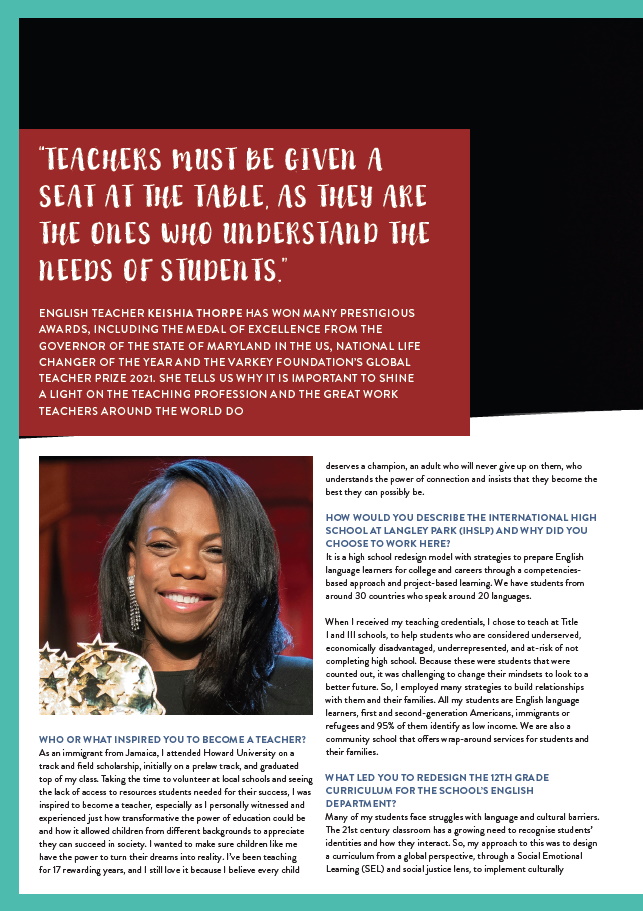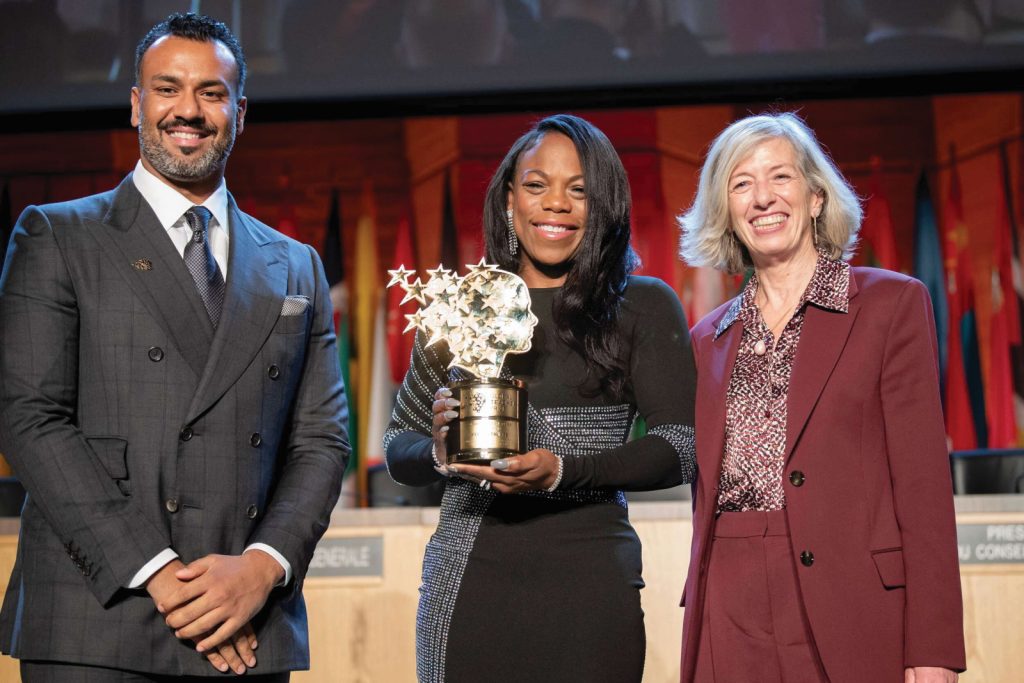“Teachers must be given a seat at the table as they are the ones who understand the needs of students.”
English teacher Keishia Thorpe has won many prestigious awards, including the Medal of Excellence from the governor of the state of Maryland in the US, National Life Changer of the year and the Varkey Foundation’s Global Teacher Prize 2021. She tells us why it is important to shine a light on the teaching profession and the great work teachers around the world do
WHO OR WHAT INSPIRED YOU TO BECOME A TEACHER?
As an immigrant from Jamaica, I attended Howard University on a track and field scholarship, initially on a prelaw track, and graduated top of my class. Taking the time to volunteer at local schools and seeing the lack of access to resources students needed for their success, I was inspired to become a teacher, especially as I personally witnessed and experienced just how transformative the power of education could be and how it allowed children from different backgrounds to appreciate they can succeed in society. I wanted to make sure children like me have the power to turn their dreams into reality. I’ve been teaching for 17 rewarding years, and I still love it because I believe every child deserves a champion, an adult who will never give up on them, who understands the power of connection and insists that they become the best they can possibly be.
HOW WOULD YOU DESCRIBE THE INTERNATIONAL HIGH SCHOOL AT LANGLEY PARK (IHSLP) AND WHY DID YOU CHOOSE TO WORK HERE?
It is a high school redesign model with strategies to prepare English language learners for college and careers through a competencies-based approach and project-based learning. We have students from around 30 countries who speak around 20 languages.
When I received my teaching credentials, I chose to teach at Title I and III schools, to help students who are considered underserved, economically disadvantaged, underrepresented, and at-risk of not completing high school. Because these were students that were counted out, it was challenging to change their mindsets to look to a better future. So, I employed many strategies to build relationships with them and their families. All my students are English language learners, first and second-generation Americans, immigrants or refugees and 95% of them identify as low income. We are also a community school that offers wrap-around services for students and their families.
WHAT LED YOU TO REDESIGN THE 12TH GRADE CURRICULUM FOR THE SCHOOL’S ENGLISH DEPARTMENT?
Many of my students face struggles with language and cultural barriers. The 21st century classroom has a growing need to recognise students’ identities and how they interact. So, my approach to this was to design a curriculum from a global perspective, through a Social Emotional Learning (SEL) and social justice lens, to implement culturally responsive teaching that can better connect students to what they learn. Education is not a ‘one size fits all’ situation; therefore, I ensure all my students are represented in my curricula, integrating lessons and texts that represent their cultures and individual ways of learning. This approach has resulted in increased student attendance in class, more engagement and improved grades. It has helped me develop authentic relationships with students and improve communication with parents.
As an immigrant from Jamaica, I attended Howard University on a track and field scholarship, initially on a prelaw track, and graduated top of my class. Taking the time to volunteer at local schools and seeing the lack of access to resources students needed for their success, I was inspired to become a teacher, especially as I personally witnessed and experienced just how transformative the power of education could be and how it allowed children from different backgrounds to appreciate they can succeed in society. I wanted to make sure children like me have the power to turn their dreams into reality. I’ve been teaching for 17 rewarding years, and I still love it because I believe every child deserves a champion, an adult who will never give up on them, who understands the power of connection and insists that they become the best they can possibly be.
HOW WOULD YOU DESCRIBE THE INTERNATIONAL HIGH SCHOOL AT LANGLEY PARK (IHSLP) AND WHY DID YOU CHOOSE TO WORK HERE?
It is a high school redesign model with strategies to prepare English language learners for college and careers through a competencies-based approach and project-based learning. We have students from around 30 countries who speak around 20 languages.
When I received my teaching credentials, I chose to teach at Title I and III schools, to help students who are considered underserved, economically disadvantaged, underrepresented, and at-risk of not completing high school. Because these were students that were counted out, it was challenging to change their mindsets to look to a better future. So, I employed many strategies to build relationships with them and their families. All my students are English language learners, first and second-generation Americans, immigrants or refugees and 95% of them identify as low income. We are also a community school that offers wrap-around services for students and their families.
WHAT LED YOU TO REDESIGN THE 12TH GRADE CURRICULUM FOR THE SCHOOL’S ENGLISH DEPARTMENT?
Many of my students face struggles with language and cultural barriers. The 21st century classroom has a growing need to recognise students’ identities and how they interact. So, my approach to this was to design a curriculum from a global perspective, through a Social Emotional Learning (SEL) and social justice lens, to implement culturally responsive teaching that can better connect students to what they learn. Education is not a ‘one size fits all’ situation; therefore, I ensure all my students are represented in my curricula, integrating lessons and texts that represent their cultures and individual ways of learning. This approach has resulted in increased student attendance in class, more engagement and improved grades. It has helped me develop authentic relationships with students and improve communication with parents.
WHAT CHALLENGES DID YOU HAVE TO OVERCOME TO MAKE THIS CURRICULUM CHANGE?
With the language barriers of students who, in the pandemic, had little or no socialisation with their peers and major learning loss due to extended school closure, I had to get innovative. I had to find ways to ensure my English language learner students had social and academic interaction with native speakers to help with their comprehensibility and language acquisition. This is not only a chance to learn English; students also have an opportunity to share their language, develop social and cultural awareness, form relationships, and build their self-confidence with the English language.
CAN YOU GIVE SOME EXAMPLES OF CURRICULUM CHANGES THAT HAVE LED TO A 40% INCREASE IN YOUR STUDENTS’ READING ABILITIES?
At first, I had to consider my student’s language proficiency levels and make sure I am differentiating to make the content accessible. Then, I had to rethink my approach to amplify students’ voices and take them on a learning journey, aligning what I am teaching to students’ culture and current events in society. Connection has been a challenge here since the pandemic, but I tried to stay creative. I had to take a few media arts classes so I could engage students in the content and help navigate their learning. I used Google Classroom as my main platform to teach students and for them to collaborate with their peers.
Focus and momentum is another challenge. To make learning new and interesting, I used many interactive online sources such as WeVideos, Flipgrid and many others. I also brought in two innovations that yielded positive outcomes for my students: a new Language Exchange Program, which I developed by partnering with schools in the Bahamas and taking the social justice approach with my curriculum redesign.
In the course, we explore students’ own identities amidst racial tensions, their stories,_ civic responsibilities, and the role of men and women in society. We analyse how literature teaches us about just and unjust societies. We research the identity and struggles of other_ minority groups, and focus on social justice from another perspective. We choose an issue_ in the students’ community, conduct research and interviews, and write letters to community and school leaders with a proposal for change. This challenges the students to think local, while acting both locally and globally through social media campaigns.
I also adopted the Global Classroom DC curriculum under the Model United Nations USA, and my students attended the Model UN Conference, representing a country and various global topics. They collaborated with their peers globally and nationally to engage with the Sustainable Development Goals of 2030.
YOU ALSO CO-FOUNDED US ELITE INTERNATIONAL TRACK AND FIELD, INC. WITH YOUR TWIN SISTER DR TREISHA THORPE. WHY DID YOU SET THIS UP AND WHAT IS ITS AIM?
Having attended Howard University on a fully funded track and field and academic scholarship, and having derived tremendous personal and lifelong career benefits from this, I wanted to help others in my position realise the same advantages. So, after graduating, Treisha and I set up US Elite in 2005 as a registered non-profit organisation. It comprises athletes with a passion for track and field and who want to continue to excel during or after their college years. We also welcome at-risk high school student-athletes who are looking for scholarship opportunities to continue with track and field and their academic pursuits.
Our Liaison International Scholarship Program helps students worldwide from low-to-moderate income households and those considered at risk to access higher education and graduate college debt-free to help remove their barriers to success. During the pandemic, when so many high schoolers faced an uncertain future, US Elite was one of the first to organise an international virtual college event to enlighten students about changes to college admissions, giving them and their families hope. With SAT exams cancelled, which so many need to attend colleges in the US, I collaborated with other teachers and coaches worldwide, and a SAT company, to offer free SAT prep classes and SAT practice exams each quarter. I mentor and assist students from many different countries in the college matriculation process.
YOU HAVE WON QUITE A FEW PRESTIGIOUS AWARDS. WHAT DOES THIS MEAN TO YOU?
I am grateful that these prizes have brought new attention to the education causes I care passionately about. The Global Teacher Prize, in particular, shines a light on the teaching profession and the great work teachers do all over the world, so it is a huge honour to have been selected. I want to thank Sunny Varkey and the Varkey Foundation for the platform the Global Teacher Prize now gives to teachers, helping tell their stories while raising the status of the profession.
WHAT ARE YOUR TOP TIPS FOR TEACHERS WHO WANT TO MAKE AND DIFFERENCE TO THEIR STUDENTS’ LIVES?
As I said, I believe every child deserves a champion, an adult who will never give up on them, who insists that they become the best they can possibly be. From my personal perspective, it’s also about being committed to your school community, mentoring new teachers, designing and sharing best practice with your team and presenting these in your professional learning communities.
I encourage teachers to follow their passions in education outside of the classroom, to help create greater social impact in their school communities. Find opportunities to contribute to public debates, attend board of education meetings and advocate on students’ behalf. I have testified on a whole range of issues, including teacher retention and funding, improvements in schools and teacher capacity, advocating for minority students and social justice in education, and so on.
My hope is that more educators will become involved with the community in which their students and families live. We need to do more research to continually improve the education system globally, but the system must put students first. Teachers are on the frontline but often do not get the opportunity to have an input. They must be given a seat at the table, as they are the ones who understand the needs of students. They can relay some of the challenges faced within the system and be better able to impact those policies that need changing.
ABOUT THE GLOBAL TEACHER PRIZE
On Wednesday 10 November 2021, US teacher Keishia Thorpe was named winner of the Varkey Foundation Global Teacher Prize, in partnership with UNESCO. Now in its seventh year, the US$1 million award is the largest prize of its kind.
Keishia was selected from over 8,000 nominations and applications for the Global Teacher Prize from 121 countries around the world. She currently teaches English to 12th grade students at the International High School Langley Park in Maryland, USA, a school where 100% of her students are English language learners and 95% identify as low-income.
Keishia completely redesigned the 12th grade curriculum for the English department to make it culturally relevant to her students who are first-generation Americans, immigrants, or refugees from mostly Africa, the Middle East, the Caribbean, and South and Central America. As a result of her interventions, her English language learners have shown a 40% increase in their reading, which contributed to the school meeting its growth-to-target rate with a 10% increase in WIDA scores for 2019-2020 and the highest in the school district for ELLs.
For more information, visit: www.globalteacherprize.org



